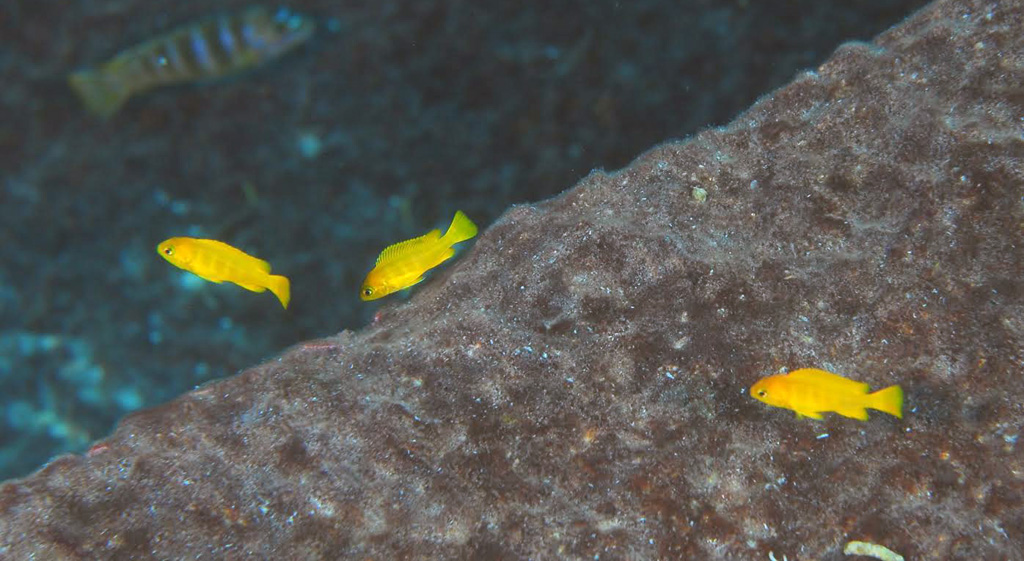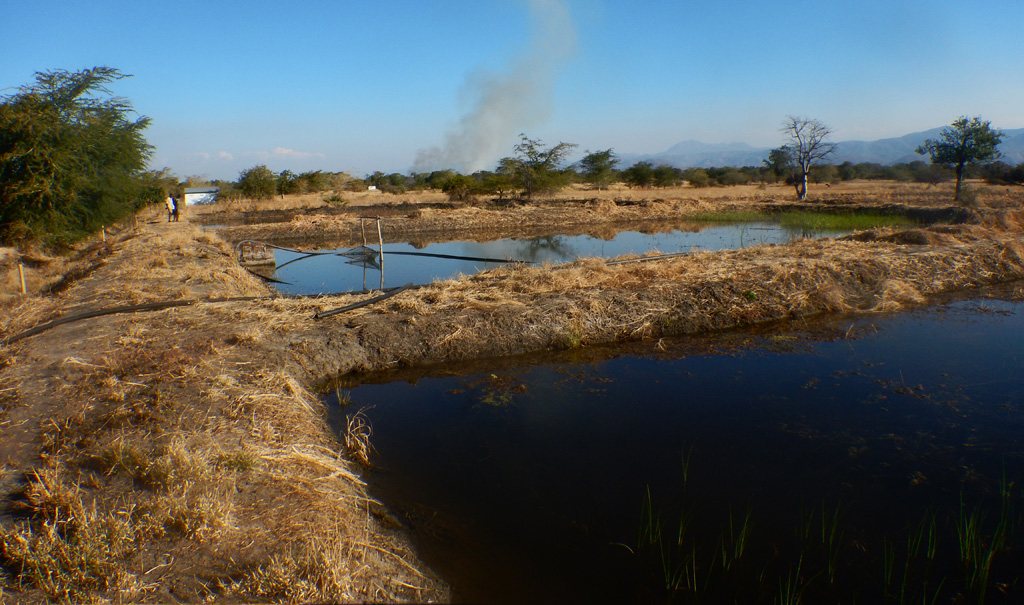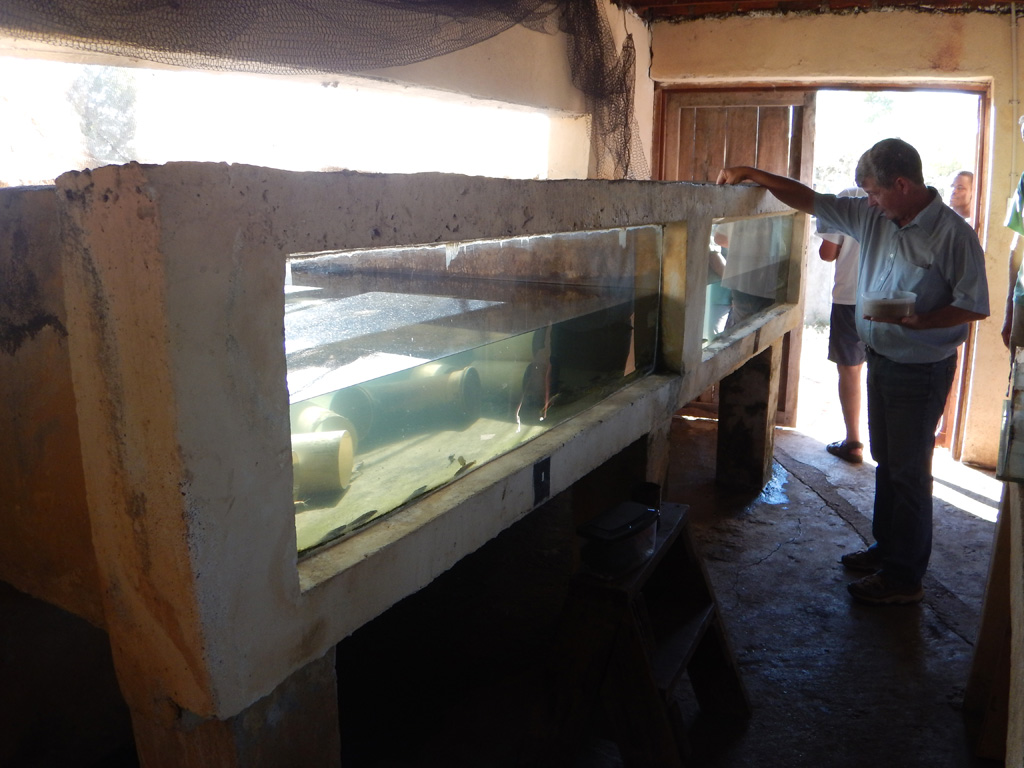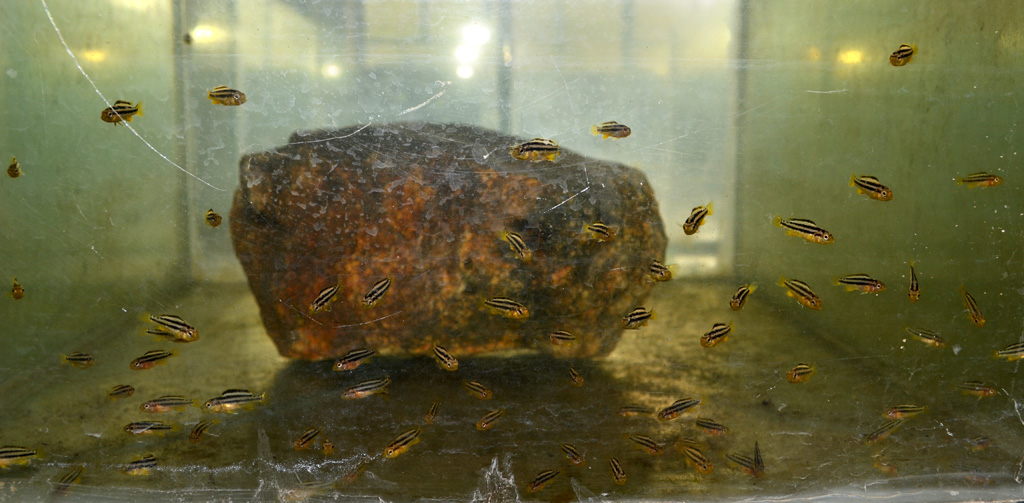Dear Friends, Here follows a short update on what happened since last summer on the cichlid conservation front in Malawi and Tanzania. Last October Larry Johnson and his safari group went again to Taiwanee Reef to check on the developments of the Saulosi (now called Chindongo saulosi). Stuart Grant Ltd at Kambiri Point continues to breed this species and David had given Larry about 65 juveniles and about 100 babies to reintroduce at the reef. Because of the extreme low lake level—the 2016 rainy season was very poor in Malawi with little or no rain at all—they could see the rocks at the reef and didn’t use the GPS to locate it. Larry said that he was at a different part of the reef where he hadn’t been before. He did a count by himself for 10 minutes at a depth where there was a good number of C. saulosi, but not as many as he remembered from last year at the other part of the reef. Nevertheless he counted about 150 fish! There were no groups travelling around the reef and they seemed to be in spawning mode. Larry figures that this part of the reef is separated from the usual spot by a deep crack, the bottom of which he couldn’t see. This suggests that collectors of ornamental fish, who have undoubtedly collected fish at both parts of the reef, haven’t been extracting C. saulosi for a while and that this appears to have helped this species to reestablish itself. I want to thank Larry and his friends for releasing the C. saulosi, now for the fourth time, and also everyone who refrained from buying wildcaughts or asked wholesalers to import some. Everything points to a recovery of this species. |
 Some of the juvenile Chindongo saulosi released last October at Taiwanee Reef Some of the juvenile Chindongo saulosi released last October at Taiwanee Reef Photo by Larry Johnson. |
|
When Pam, Mattia, John, Martin, and I were in Malawi last June (see previous update July 2016) we were disappointed by the hostility of the local fishermen and by the inability of the Malawi government to enforce the no-fishing rules in park waters. Still I found it important to continue breeding a few more species that had been overfished by collectors of ornamental fishes. While David at Stuart Grant Ltd still continues breeding C. saulosi, he declined breeding some other species of which I think they are threatened. While we were on Nankoma Island (Blue Zebra Island Lodge) we were contacted by Pierre le Roux, owner of a fish farm at Chipoka. We visited him and he showed us the farm. |
 Some of the grow-out ponds at Pierre le Roux's fish farm in Chipoka. Photo by Pam Chin. |
Pierre’s specialty is breeding the local tilapias—Oreochromis squamipinnis, O. shiranus, and Coptodon rendalli—which was initially also the reason he had contacted Estelle and Matt at the lodge. However, since he also had kept the ornamental Malawi cichlids when he was younger, he later agreed to breed two other species for us: Melanochromis chipokae and Aulonocara baenschi (from Nkhomo Reef). |
 Pierre feeding some juvenile kampango in home-made tanks. Photo by Mattia Matarrese. |
Pierre is a man of action as within two months of agreement he had collected himself, using hand nets(!), enough breeders of M. chipokae to set up a breeding colony. And early November he had the first fry of these breeders! He just reported that he has 76 large juveniles which should be released this year. He now also obtained, from the local ornamental fish collector in Chipoka, breeding stock of A. baenschi, but since they were small fish he first needs to grow them up. He expects to breed with them later this year. Thank you, Pierre! |
 The first batch of fry of Melanochromis chipokae. Photo by Pierre le Roux. |
Chris and Louise Horsfall managed to repair the breeding vats—they were lacking waterproofing in the bottom causing to drain water at a fast speed. Now everything is up and running and in two weeks he will have a diver/collector catch the first breeders of Ophthalmotilapia boops and possibly Tropheus moorii. |
 A male Ophthalmotilapia boops at Nkondwe Island. |
With government endorsement Chris also started a tilapia breeding program at the lodge. They are breeding Oreochromis tanganicae, the tilapia found throughout the lake. He’s built some grow-out vats for the fingerlings. The plan is to sell the fish locally so that the demand to catch this species in the lake is reduced. Besides growing these fish to sellable size he also plans to supply the fingerlings to small scale fish farmers who grow them out in cages in the lake—exactly what Pierre le Roux is doing in Lake Malawi. And yet another project Chris is working on is to provide a kind of baseline report on the numbers of individuals of some of the threatened species in the lake. In talks with the Fisheries Department it became clear that in order to prove overfishing is taking place they need population density numbers before the extraction started. Of course it is too late to produce such, but the sooner we have figures for a certain species at a certain place the better. This is still in the development phase, but we plan to count the populations of O. boops and T. moorii Tanzania Murago, and some geographical variants of these species that are not overfished for the ornamental fish trade. This will give us an idea what the original population density of these two species could have been. Since it is difficult to count fish in transects in rocky habitats, we are planning to use small fixed cameras that take pictures at intervals for a certain time. Since these cameras operate independently the fish won’t hide once the diver has left the area under study. Another bonus to this setup is that the photos can be evaluated and re-evaluated by various people indefinitely and also that they will become an essential part in proving overfishing. The Fund will provide the cameras, perhaps a laptop to evaluate the photos, and we’ll also pay logistics, local lodging, and a small stipend for a Tanzanian student who is performing the study. We plan of having the person count the fish twice a year at 4-5 different sites. Last year was a great year for our fundraising as we received almost $9,500! Our total from 2007 till now stands at $79,230! I would again like to thank the Babes In The Cichlid Hobby for their faithful and large donation to the Fund. Their auctions and antics at ACA conventions make donating for the preservation of cichlids an entertaining pleasure. Thank you again ladies! |
 Here are a few Babes In The Cichlid Hobby, there are many more! Whitney, Pam, Pam, Caroline, and Sandy. Photo by Pam Chin. |
I’m also indebted to the Nordiska Ciklidsällskapet (Scandinavian cichlid society) for fundraising among their membership which resulted in $1021 for the Fund! Tack så mycket! Dick Au, a good friend of mine, again made a huge year-end donation to the Fund! Thank you, Dick! The new year started well with a large donation from Jay Wilson of Northfin USA; thank you, Jay! Remember that a portion of each package of Frozen Cichlid Formula of Omega One supports the Fund! Thank you all for your support and concern for our cichlids in the wild. Ad |
